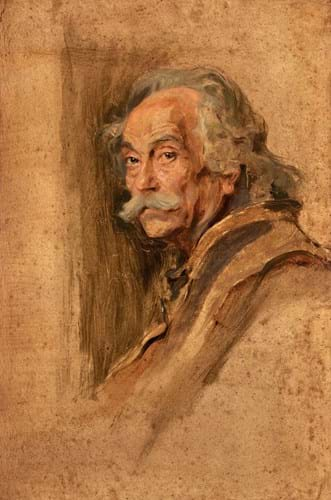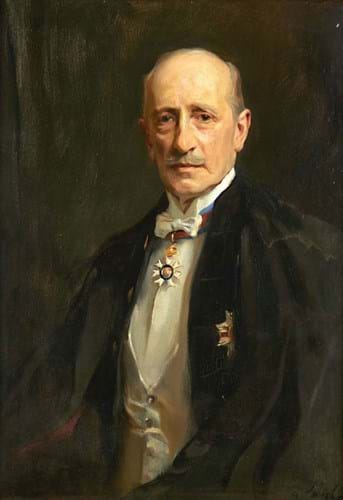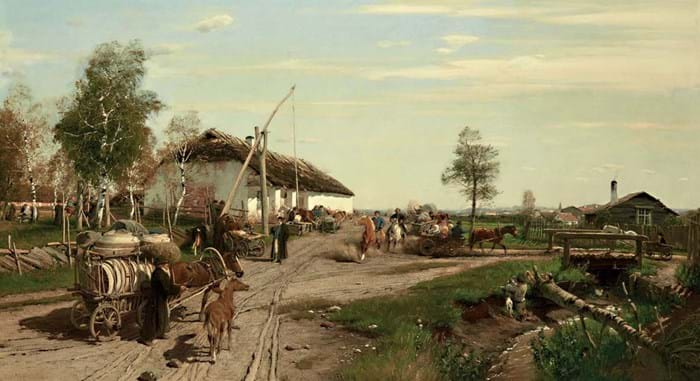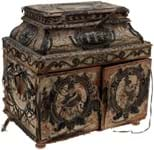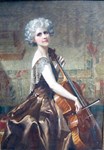
Spanish Dancers by Philip de László, £30,000 at Roseberys.
Photo: de Laszlo Archive © de Laszlo Foundation
According to the Collins dictionary, the term ‘conversation piece’ has two different meanings when it comes to art.
The first is quite narrowly defined: a group portrait in a landscape setting, particularly popular in 18th century England. The second is more general: an object that simply provokes conversation, especially something unusual.
When it comes to the market for portraits, sometimes people ask why collectors choose to buy pictures of people (often long dead) with whom they seemingly have no connection.
Perhaps factors relating to that second definition could be one of the reasons behind it. You might call it the ‘dinner party appeal’ – an intriguing work hanging on a wall that acts as a topic for discussion, allowing the host to regale guests with an interesting anecdote or two.
Portrait doubles up
With this in mind, it is relatively easy to imagine the talking point of an arresting double portrait that emerged this summer at south London saleroom Roseberys (25% buyer’s premium).
The painting by the renowned portraitist Philip de László (1869- 1937) depicted two flamenco dancers that the artist met at a Spanish club.
According to the Hungarian-born artist’s studio inventory, de László “invited the Senora to pose for him. She arrived with her partner (her husband) and to avoid any jealousy they were painted as a group. The Senor, however, was annoyed to find himself providing a background for his wife’s figure.”
The 3ft x 2ft 3in (92 x 68cm) signed oil on board was dated 1927. It was seemingly painted in the artist’s London studio (it appears in a photograph of the setting from 1930 showing it alongside a number of mid-to-late 1920s portraits).
De László produced a number of portraits of Spanish dancers over the last 30 years of his career. He was seemingly drawn to the subject after viewing John Singer Sargent’s masterful painting El Jaleo when he visited Boston in 1908.
“No contemporary picture has impressed me so profoundly”, de László remarked.
Choosing to depict his sitters in their elaborate and distinctive costume, he painted the dancer and actress Tina Meller (née Agustina Marqués López) on multiple occasions wearing Spanish dress. One example from 1929 sold for £19,000 at Christie’s in December 2021.
He also painted another dancer, Adrina Otéro, wearing a traditional flamenco skirt and holding a guitar in 1935 – a work that was described in the Roseberys catalogue as comparable with the current work.
Both pictures were freely painted with loose brushwork which the artist used to create a sense of swirling movement and spirited gestures. De László famously worked at tremendous speed and, although the lower part of the current picture was unresolved, the spontaneity of the picture meant this may not have affected it as much commercially as might be imagined.
Indeed, it was a similar case with a portrait of Lady Northcliffe at Cirencester auction house Moore Allen & Innocent last year. However, that supposedly ‘unfinished’ picture nevertheless still made £32,000, a sum thought to be the highest for de László at a UK sale outside London (see ATG No 2552).
The current picture was familiar to the trade, having sold at Phillips in 1993 for £1000 and later appearing in a 2011 catalogue from the now defunct dealer Trinity House Paintings. According to the Roseberys catalogue, it was consigned to the auction on July 19 from a UK private collection.
Estimated at £15,000-20,000, it drew a decent contest on account of its many qualities (rather than the fame of the sitter which is often the decisive factor in the de László market).
After strong interest from online bidders, it was eventually knocked down at £30,000 to a UK collector – a sum that underlined the significant growth in the artist’s market in the 30 years since the Phillips sale.
Now there’s a conversation starter too.
Trio from same source
Spanish Dancers was, in fact, one of three de Lászlós offered at the West Norwood auction from the same source. The same buyer also bought a work further down the price-scale: a portrait of a Hungarian peasant with a moustache from the artist’s earlier period.
While de László made his name in his native Hungary as a painter of genre scenes, depicting characters and settings from local peasant life, such works tend to be less commercial than his later portraits of prominent contemporaries (famously the artist’s sitters included monarchs, presidents and even a pope).
This 2ft 6in x 20in (75 x 51cm) oil on board dated from c.1901 but the time-worn face of the sitter resembled those in a significant work from around eight years earlier: Regret, or Love Spurned which is now in the Hungarian National Gallery.
Although the humble subject meant it was unlikely to reach the lucrative six-figure heights of the de László market, its performance was still slightly underwhelming when it sold below estimate at £3600.
The third work by the artist at Roseberys was a classic de László portrait of a male sitter from the artist’s mature period. It performed markedly better, selling at £28,000 to a different UK private collector against a £5000-7000 pitch.
The 2ft 8in x 23in (82 x 58.5cm) oil on canvas depicted Sir Henry Birchenough, 1st Baronet, wearing white tie evening dress. It dated from 1926, a year after he was appointed president of the British South Africa Company, a position he held until his death in 1937.
An exact copy of the portrait was painted by Sydney Percy Kendrick for the Bulawayo Club in Zimbabwe where, presumably, it was also a source of conversation at the famous gentleman’s club.
Hoffmann on a high
Elsewhere at the Roseberys sale, a large landscape by Oskar Hoffmann (1851-1913) set a record for the artist at auction. Village Crossroads, a 21¾in x 4ft (56cm x 1.21m) oil on canvas, was clearly a major work and was described as ‘lively and finely executed’ by the auction house.
The Baltic German painter, who was born and raised in Estonia, enrolled at the Kunstakademie Düsseldorf in 1872. He later travelled to St Petersburg in Russia where, in 1884, he was granted the status of ‘Free Artist’ by the Imperial Academy of Arts.
His work predominantly featured rural scenes of Estonia although he also produced some coastal views and figurative paintings.
This example had previously sold at Christie’s in 1992 for £11,500 but here, where it was consigned by from a UK private collection, it was estimated at a conservative £3000-4000.
This pitch helped attract bidders and, after a strong competition, it was knocked down at £28,000 to a private collector in Estonia – the highest price for Hoffmann according to Artprice.com.


